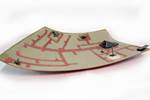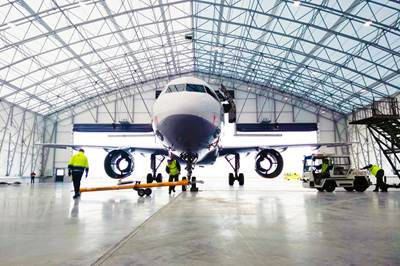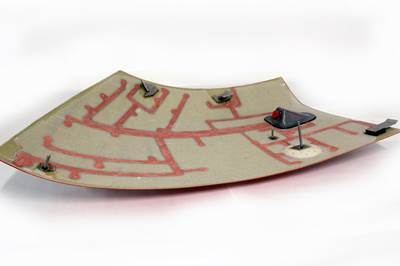INVENT GmbH celebrates 25 years in composites
Founded in 1996 as an outlet for lightweight construction, the DLR spin-off notes its extensive growth, contract successes and near future goals.
Share
Read Next

INVENT CEO Henning Wichmann and CTO Carsten Schöppinger. All Photo Credit: INVENT GmbH
Founded in 1996, aerospace SME Innovative Verbundwerkstoffe, Realization & Vermarktung neuer Technologien, or INVENT GmbH (Braunschweig, Germany), is celebrating 25 years in the industry. As of today, the company employs around 90 individuals and expects to grow its growth trajectory. Connected and rooted in the Braunschweig research region, INVENT GmbH operates across European borders and the Asian market.
“We have been working in composite lightweight design for a quarter of a century, a topic that originally played a major role primarily in aerospace, but now increasingly in other high-tech areas as well,” explains Henning Wichmann, CEO, INVENT. “This is because weight savings bring economic advantages in aerospace, but also in other industries. The lighter a satellite or an aircraft is, the less fuel and energy is needed. At the same time, the materials in these industries must be extremely resilient. Materials must fulfill very high thermal, mechanical, electrical and radiation-protection requirements.”
Founded in Braunschweig, Germany, the company says its first headquarters was a two-story, 160-square-meter residential builder, three partners and two employees.
“We were diagonally opposite the tax office, which is not nice as an entrepreneur. And my office was in the original bedroom of the house,” Wichmann recalls.
Initial circumstances did not keep Wichmann from working hard: Twenty-five years later, the small think tank that started out as a spin-off of the Institute of Lightweight Design and Adaptronics of the German Aerospace Center (DLR, Braunschweig, Germany), with 25,000 Deutsche Mark (approx. $15,000 USD) in start-up capital, has become a medium-sized company with around 90 employees that is firmly integrated in international aerospace projects.
“I would never have dared to dream of this development in 1996, but I am pleased and also a little proud of what we have achieved in the last quarter of a century,” says Wichmann.
It was Wichmann and current CTO, Carsten Schöppinger, that built INVENT from the ground up. Both individuals met in the mid-1990s as graduate engineers at the University of Applied Sciences in Wolfenbüttel. There, they made the acquaintance of Prof. Holger Hanselka. Soon after that, they met the other founders and first partners of INVENT at DLR: Prof. Elmar Breitbach and Prof. Axel Herrmann. The professors first looked for student assistants and then, in 1996, two managing directors with commercial and technical experience for their planned DLR spin-off.
“INVENT would also like to expand contacts in the growing space-travel start-up scene.”
“We were, and still are, closely connected with the DLR through cooperation agreements. But the goal of INVENT then, as now, was to create an outlet into the market for lightweight construction and also to mass-produce products. This is not possible on a larger scale in a research center that focuses on research and teaching,” says Wichmann. Still at the helm of INVENT, he and Schöppinger are also the main shareholders of the Braunschweig SME; 30% of the company belongs to an employee GbR, as well as other, smaller shareholders.

INVENT headquarters in Braunschweig, Germany.
“We received our first series order from the then aircraft manufacturer Dornier in 1997. We quickly realized that we needed our own production facility in the medium term, and we started with the corresponding plans in 2000. In 2002, we moved to our first location in the Braunschweig industrial area,” Schöppinger reports.
In 2006, the company applied for a contract with the aviation company Airbus (Toulouse, France) with success. INVENT GmbH says it manufactured— and still manufactures — structures for the A380, as well as the A320 and A330. “In 2008, we were able to manufacture and deliver the products for Airbus, but not to rework them, not to paint them, not to test them. That’s why we have successively expanded the value chain in-house and can now offer our customers much more from a single source with know-how and extensive plant technology from the initial idea to series production,” adds Wichmann.
The first major space projects followed in 2010. INVENT highlights a recent contract for the production of lightweight components for four earth observation satellites from the European Copernicus program. “That was a huge success for us and shows that we are on the right track with our commitment and know-how, and that we have built up and expanded a lot of experience and reliability over the past 10 years, not only in our traditional field of aeronautics, but also in space travel,” says Wichmann.
Today, INVENT GmbH is based on three business areas, including aviation, space travel and other sectors such as rail, automotive or wind energy. The company also maintains a research and development (R&D) unit that works for all areas, for example, also acquires projects from public tenders throughout Germany or Europe.
“All this time, we were not so much concerned with maximum profits, but rather with moderate and stable growth,” says Wichmann. He says his vision for the next few years as well includes healthy growth, and the ability and the means to successfully place new products (e.g., radiators or CFRP tanks) on the market. This means continuing to do their homework and deal with customers and suppliers properly.
“A major challenge is the digitalization of the company’s processes, the implementation of which is in full swing. In addition, following the recent move within the Braunschweig industrial estate two years ago, at least one more building is to be constructed in the immediate vicinity with an expansion of production and office space; the market has become bigger. INVENT would also like to expand contacts in the growing space-travel start-up scene,” concludes Wichmann. “Elon Musk is showing us the way in the U.S. If we succeed in establishing innovative products in new and existing markets, we will have 20 to 30 more employees in ten years.”
Read Next
German composite specialist INVENT collaborates in SUSTAINair for increased aircraft circularity
Three-and-a-half-year, 11-partner EU project will include metals and composites spanning design, manufacturing, maintenance, repair, assembly and recycling.
Read MoreINVENT GmbH demonstrates sensor network for structural monitoring on composite railcar structures
Patented DuraAct technology uses piezo-ceramics to detect damage in Deutsche Bahn train side skirts as part of faWaSiS research project.
Read MorePlant tour: Daher Shap’in TechCenter and composites production plant, Saint-Aignan-de-Grandlieu, France
Co-located R&D and production advance OOA thermosets, thermoplastics, welding, recycling and digital technologies for faster processing and certification of lighter, more sustainable composites.
Read More














.jpg;maxWidth=300;quality=90)







